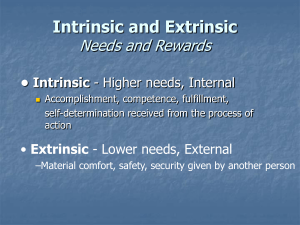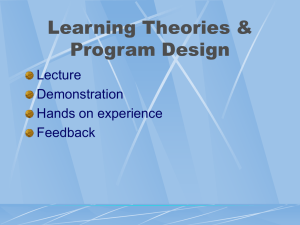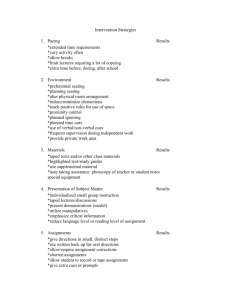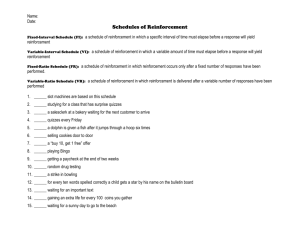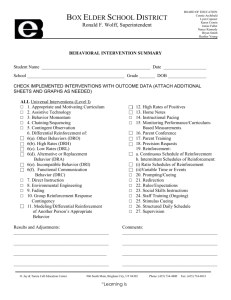True/False Questions
advertisement
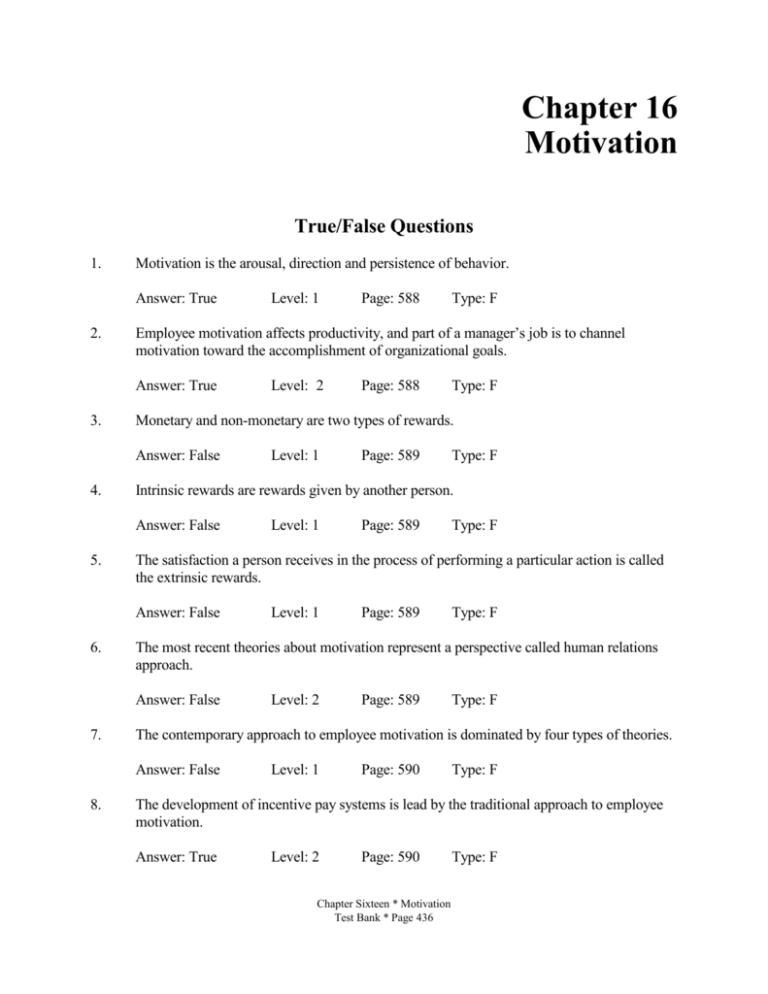
Chapter 16 Motivation True/False Questions 1. Motivation is the arousal, direction and persistence of behavior. Answer: True 2. Level: 1 Page: 589 Type: F Level: 1 Page: 589 Type: F Level: 1 Page: 589 Type: F Level: 2 Page: 589 Type: F The contemporary approach to employee motivation is dominated by four types of theories. Answer: False 8. Type: F The most recent theories about motivation represent a perspective called human relations approach. Answer: False 7. Page: 588 The satisfaction a person receives in the process of performing a particular action is called the extrinsic rewards. Answer: False 6. Level: 2 Intrinsic rewards are rewards given by another person. Answer: False 5. Type: F Monetary and non-monetary are two types of rewards. Answer: False 4. Page: 588 Employee motivation affects productivity, and part of a manager’s job is to channel motivation toward the accomplishment of organizational goals. Answer: True 3. Level: 1 Level: 1 Page: 590 Type: F The development of incentive pay systems is lead by the traditional approach to employee motivation. Answer: True Level: 2 Page: 590 Chapter Sixteen * Motivation Test Bank * Page 436 Type: F 9. The human relations approach carries the concept of economic man and social man further to introduce the concept of the whole person. Answer: False 10. Type: F Level: 1 Page: 590 Type: F Level: 1 Page: 591 Type: F Level: 2 Page: 591 Type: F Level: 2 Page: 591 Type: F Level: 2 Page: 591 Type: F The first two groups of needs in Aldefer's ERG theory are external and relatedness. Answer: False 18. Page: 590 Esteem needs are those needs that relate to the desire for a positive self-image and to receive attention, recognition, and appreciation from others. Answer: True 17. Level: 2 The highest level of need in Maslow's hierarchy of need theory is the need for growth and self-expression. Answer: False 16. Type: F Food, water, and freedom from violence are examples of physiological needs in Maslow's hierarchy of needs theory. Answer: False 15. Page: 590 Physiological needs are the most basic human physical needs, which are reflected in the workplace as needs for adequate heat, air, and base salary. Answer: True 14. Level: 2 Content theories concern the thought processes that influence behavior. Answer: False 13. Type: F Content theories, process theories, and reinforcement theories are three categories of motivation theories. Answer: True 12. Page: 590 Process theories emphasize the needs that motivate people. Answer: False 11. Level: 2 Level: 2 Page: 592 Type: F Many companies are finding that creating a humane work environment that allows people to achieve a balance between work and personal life is also a great high-level motivator. Answer: True Level: 2 Page: 592 Chapter Sixteen * Motivation Test Bank * Page 437 Type: F 19. Herzberg's two-factor theory divides work-related needs into two categories: hygiene factors and reward factors. Answer: False 20. Page: 594 Type: F Level: 2 Page: 594 Type: F Level: 3 Page: 594 Type: F Level: 2 Page: 595 Type: F Level: 3 Page: 596 Type: F A high need for power often is associated with successful attainment of top levels in the organizational hierarchy. Answer: True 27. Level: 2 The equity theory focuses on individual’s perceptions of how fairly they are treated relative to others. Answer: True 26. Type: F A need for power, a need for accomplishment and a need for superior power is proposed by David McClelland's acquired needs theory. Answer: False 25. Page: 594 The implication of the two-factor theory for managers is clear. Providing hygiene factors will eliminate employee dissatisfaction but will not motivate workers to high achievement levels. Answer: True 24. Level: 1 Hygiene factors are the same as satisfiers and are based on fulfillment of higher level needs including responsibility. Answer: False 23. Type: F Hygiene factors are the same as dissatisfiers and include company policies and procedures. Answer: True 22. Page: 594 Motivators are factors that influence job satisfaction based on fulfillment of high-level needs such as achievement, recognition, and opportunity for growth. Answer: True 21. Level: 2 Level: 2 Page: 596 Type: F Process theories are the group of theories that explain how employees meet their needs and determine their success. Answer: True Level: 1 Page: 596 Chapter Sixteen * Motivation Test Bank * Page 438 Type: F 28. A process theory that focuses on individuals' perception of how fairly they are treated in comparison to other people is called equality theory. Answer: False 29. Type: F Level: 2 Page: 598 Type: F Level: 1 Page: 599 Type: F Level: 2 Page: 599 Type: A Level: 3 Page: 600 Type: A Level: 1 Page: 601 Type: F Avoidance learning is the imposition of unpleasant outcomes on an employee. Answer: False 37. Page: 598 Behavior that is positively reinforced tends to be repeated, and behavior that is not reinforced tends not to be repeated, as stated in the Law of Effect. Answer: True 36. Level: 1 The expectancy theory of motivation is similar to Fiedler's contingency model of leadership in that both emphasize subordinates needs and goals. Answer: False 35. Type: F According to expectancy theory, for an employee to be highly motivated, E-P expectancy and valence must be maximized. Answer: True 34. Page: 596 The perceived value of a reward or outcome is valence. Answer: True 33. Level: 2 According to the expectancy theory, motivation increases when the worker believes that the successful performance will result by putting effort into a given task. This is called E-P expectancy. Answer: True 32. Type: F Expectancy theory is based on the relationship among the individual's effort and performance and not on the desirability of outcomes. Answer: False 31. Page: 596 The equity theory, by J. Stacy Adams, states that equity exists when the ratio of outcomes to inputs for one person is equal to the same ratio for another person. Answer: True 30. Level: 2 Level: 2 Page: 601 Type: F The withdrawal of positive reward refers to extinction. Chapter Sixteen * Motivation Test Bank * Page 439 Answer: True 38. Page: 603 Type: F Level: 2 Page: 604 Type: F Level: 1 Page: 607 Type: F Level: 2 Page: 607 Type: F Level: 1 Page: 609 Type: F The job characteristic of autonomy influences the worker's experiencing meaningfulness of work. Answer: False 45. Level: 2 Task significance is the degree to which the job is perceived as important and having an impact on the company or customers. Answer: True 44. Type: F Job simplification is based on principles drawn from scientific management and industrial engineering. Answer: True 43. Page: 602 A job design that incorporates achievement, recognition, and other high-level motivators into the work is called job enlargement. Answer: False 42. Level: 1 The variable-ratio schedule is based on a random number of desired behaviors. Answer: True 41. Type: F The fixed ratio schedule rewards employees at specified time intervals. Answer: False 40. Page: 602 Schedule of reinforcement is the frequency with which reinforcement occurs. Answer: True 39. Level: 1 Level: 2 Page: 609 Type: F Empowering employees means giving them four elements that enable them to act more freely to accomplish their jobs: information, knowledge, power, and rewards. Answer: True Level: 2 Page: 611 Type: F Multiple Choice Questions 1. ______ is the arousal, direction, and persistence of behavior. a. Commitment Chapter Sixteen * Motivation Test Bank * Page 440 b. c. d. e. Motivation Satisfaction Rewarding behavior Behavior modification Answer: b 2. Level: 1 Page: 589 Type: F Jessica dislikes almost everything about her job. The only reason she continues to work at Knight Autobody is the excellent benefits package she receives. Jessica is motivated by a. b. c. d. e. extrinsic rewards. intrinsic rewards. variable rewards. all of the above. none of the above. Answer: a Level: 2 Page: 589 Type: A Which of the following is an example of an intrinsic reward? a. b. c. d. e. An employee's feelings of self-worth A pat on the back from your boss A pay raise A promotion A bonus Answer: a 5. Type: F An intrinsic reward An internal reward An extrinsic reward A valued reward A charity Answer: c 4. Page: 588 Which of these refers to a reward given by another person? a. b. c. d. e. 3. Level: 1 Level: 2 Page: 589 Type: F The __________ to motivation led to the development of incentive pay systems. a. b. c. d. e. human resources approach organizational approach human relations approach traditional approach contemporary approach Chapter Sixteen * Motivation Test Bank * Page 441 Answer: d 6. Page: 590 Type: F contemporary approach. human resource approach. human relations approach. traditional approach. reinforcement approach. Answer: d Level: 2 Page: 590 Type: F Which of the following motivational techniques is consistent with the traditional approach to motivation? a. b. c. d. e. Sensitivity training The Hawthorne effect Incentive pay systems Need satisfaction Recognition banquet Answer: c Level: 2 Page: 590 Type: F Under which approach, noneconomic rewards first became popular? a. b. c. d. e. The traditional approach The contemporary approach The human resource approach The human relations approach The situational approach Answer: d 10. Level: 1 The perception of workers as economic people is consistent with the a. b. c. d. e. 9. Type: F human resources approach. organizational approach. human relations approach. traditional approach. contemporary approach. Answer: b 8. Page: 590 All of these are perspectives on motivation described in your text EXCEPT the a. b. c. d. e. 7. Level: 2 Level: 2 Page: 590 Type: F The human resource approach is most closely associated with which of the following? a. The economic person Chapter Sixteen * Motivation Test Bank * Page 442 b. c. d. e. The social person The whole person The partial-man approach The reinforced approach Answer: c 11. Level: 1 Page: 590 Type: F Content and process theories of motivation are found in which approach to motivation? a. b. c. d. e. The traditional approach The contemporary approach The human relations approach The human resource approach The whole person approach Answer: b Level: 2 Page: 590 Type: F Which of the following theories emphasize the needs that motivate people? a. b. c. d. e. Process Reinforcement Content Contingency Situational Answer: c 14. Type: F Process Reinforcement Content Needs Maslow’s Answer: a 13. Page: 590 _________ theories concern the thought processes that influence behavior. a. b. c. d. e. 12. Level: 2 Level: 1 Page: 590 Type: F Which of the following is NOT a need proposed by Maslow in his hierarchy of needs theory? a. b. c. d. e. Safety needs Compensation needs Physiological needs Esteem needs Self-actualization needs Chapter Sixteen * Motivation Test Bank * Page 443 Answer: b 15. Level: 2 Page: 591 Type: A Which component of Maslow’s hierarchy of needs describes the most basic human physical needs, including food, water and oxygen? a. b. c. d. e. Self-actualization needs Physiological needs Esteem needs Belongingness needs Safety needs Answer: b Level: 2 Page: 591 Type: F Which need describes the desire to be accepted by one’s peer, have friendships, be part of a group, and be loved? a. b. c. d. e. Self-actualization needs Physiological needs Esteem needs Belongingness needs Safety needs Answer: d 18. Type: F Physiological Safety Belongingness Esteem Self-actualization Answer: d 17. Page: 591 Neil is motivated by a strong need for recognition and is continually seeking credit for his contributions to the organization. According to Maslow, Neil is motivated by which category of needs? a. b. c. d. e. 16. Level: 2 Level: 2 Page: 591 Type: F The highest order needs, according to Maslow, are a. b. c. d. e. self-actualization needs. physiological needs. esteem needs. belongingness needs. safety needs. Answer: a Level: 1 Page: 591 Chapter Sixteen * Motivation Test Bank * Page 444 Type: F 19. Alderfer referred to the needs for physical well being as a. b. c. d. e. physiological existence belongingness relatedness growth Answer: b 20. Type: F Level: 2 Page: 592 Type: A The frustration-regression principle is most closely related with a. b. c. d. e. Maslow. Herzberg. McClelland. Alderfer. Adam. Answer: d Level: 2 Page: 592 Type: F According to Herzberg, which of these is an example of a hygiene factor? a. b. c. d. e. Achievement Recognition Pay Responsibility Opportunity for growth Answer: c 23. Page: 592 growth needs. existence needs. relatedness needs. self-actualization needs. physiological needs. Answer: c 22. Level: 2 Joe is primarily driven by a need to establish close social relationships with other people. Alderfer would say she is motivated by a. b. c. d. e. 21. needs. Level: 2 Page: 594 Type: F __________ are high-level needs, according to Herzberg, and include achievement, recognition, responsibility, and opportunity for growth. a. b. Hygiene factors Extrinsic factors Chapter Sixteen * Motivation Test Bank * Page 445 c. d. e. Motivators Dissatisfiers All of the above Answer: c 24. Level: 2 Page: 594 Type: F The majority of hourly workers at Formatting Unlimited are neither satisfied nor dissatisfied. What would Herzberg recommend if your goal were to increase their level of satisfaction? a. b. c. d. e. Increase the level of hygiene factors Increase the level of motivators Decrease the level of motivators Decrease the level of hygiene factors None of the above Answer: b Level: 2 Page: 594 Type: A The desire to form close personal relationships, avoid conflict, and establish warm friendships, describes a. b. c. d. e. a need for affiliation. a need for power. a need for achievement. a need for authority. all of the above. Answer: c 27. Type: F Hygiene factors Reinforcers Motivators Dissatisfiers All of the above Answer: c 26. Page: 594 According to Herzberg, which of these has the greatest impact on job satisfaction? a. b. c. d. e. 25. Level: 2 Level: 1 Page: 595 Type: F Which of these, according to McClelland, is associated with the desire to master complex tasks? a. b. c. d. A need for affiliation A need for power A need for achievement A need for authority Chapter Sixteen * Motivation Test Bank * Page 446 e. All of the above Answer: a 28. Level: 2 Page: 595 Type: F Felix is a recent college graduate. He is unsure about his future. A counselor in his university's career resources recently told Felix that he had a high need for achievement. Based on this, what type of career should Felix pursue? a. b. c. d. e. He should look for work as a project manager. He should think about starting his own business. He should look for work in "corporate America," he is sure to climb to the top. He should play the Lotto. None of the above. Answer: b Level: 3 Page: 596 Type: A Elizabeth has a desire to influence others, be responsible for them, and have authority over them. It can be described as her a. b. c. d. e. need for power. need for achievement. need for affiliation. need for relatedness. none of the above. Answer: a 31. Type: F power achievement affiliation success expertise Answer: a 30. Page: 595 According to McClelland, a high need for ________ is associated with successful attainment of top levels in the organizational hierarchy. a. b. c. d. e. 29. Level: 1 Level: 2 Page: 596 Type: A ______ is an example of a process theory of motivation. a. b. c. d. e. Need hierarchy theory Equity theory Two-factor theory ERG theory Acquired needs theory Chapter Sixteen * Motivation Test Bank * Page 447 Answer: b 32. Level: 1 content theories. contingency theories. process theories. need hierarchy theories. reinforcement theories. Answer: c 33. Level: 1 Page: 596 Type: F theory deals with employee's perception of fairness. a. b. c. d. e. Expectancy Reinforcement Need hierarchy Equity ERG Answer: d Level: 1 Page: 596 Type: F Paula and Chris are both middle managers at Detrick International. Paula is dissatisfied because she knows that Chris makes more in salary even though, in Paula’s opinion, she works longer hours than he does. If Paula wishes to reduce this perceived inequity, what should she do? a. b. c. d. e. She could reduce the number of hours she works. She could increase her level of absenteeism. She could ask for a raise. All of the above. a and c only. Answer: d 35. Type: F Theories that explain how employees select the behaviors that allow them to meet their needs are known as a. b. c. d. e. 34. Page: 596 Level: 3 Page: 597 Type: A Which of the following is NOT a common method for reducing a perceived inequity? a. b. c. d. e. Change inputs Change outcomes Distorts perception Leave the job Change equity Answer: e Level: 2 Page: 597 Chapter Sixteen * Motivation Test Bank * Page 448 Type: F 36. Which of the following compensation strategies perpetuates inequity in the workplace? a. b. c. d. e. Cafeteria-style benefits Incentive pay systems Two-tier wage systems Gain-sharing None of the above Answer: c 37. Level: 2 Equity theory Expectancy theory Reinforcement theory Two-factor theory ERG theory Answer: b P E O A V Page: 598 Type: F -> O expectancy -> P expectancy -> V expectancy -> Z expectancy -> P expectancy Answer: b Level: 2 Page: 598 Type: F Chuck is a manager at Railroad Ties. He sees little opportunity for advancement at Railroad Ties, regardless of how well he performs. Which of the following expectancies is low for Chuck? a. b. c. d. e. E -> P expectancy O -> V expectancy P -> O expectancy E -> V expectancy None of the above Answer: c 40. Level: 1 The ___________ involves whether putting effort into a task will lead to high performance. a. b. c. d. e. 39. Type: A ______ is based on the relationships between effort, performance, and outcomes. a. b. c. d. e. 38. Page: 598 Level: 2 Page: 598 Type: A __________ describes the value or attraction an individual has for an outcome. a. b. Motivators Valence Chapter Sixteen * Motivation Test Bank * Page 449 c. d. e. O -> V expectancy P -> O expectancy E -> V expectancy Answer: b 41. Level: 3 Page: 599 Type: A Which of the following theories places an emphasis on behavior and its consequences? a. b. c. d. e. Two-factor theory Need hierarchy theory Reinforcement theory ERG theory Equity theory Answer: c Level: 1 Page: 601 Type: F Which of the following statements best summarizes the law of effect? a. b. c. d. e. All behaviors have consequences. Positively reinforced behavior tends to be repeated. Your behavior will influence others. Negatively reinforced behavior tends to be repeated. None of the above. Answer: b 44. Type: F E -> P expectancy O -> P expectancy Valence Motivators O -> E indicators Answer: c 43. Page: 599 Jill works at Kermit’s Korner. Her bosses continually indicate that her motivational level is low. Jill agrees, but is unwilling to work harder until the company changes the types of reward it offers its employees. Which of the following is low for Jill? a. b. c. d. e. 42. Level: 3 Level: 2 Page: 601 Type: F Tony publicly praises his employees when they have achieved their goals. Tony hopes this will increase the likelihood of goal achievement in the future. This is an example of a. b. c. d. e. extinction. negative reinforcement. avoidance learning. positive reinforcement. none of the above. Chapter Sixteen * Motivation Test Bank * Page 450 Answer: d 45. Page: 601 Type: F avoidance learning. punishment. positive reinforcement. extinction. inefficient management. Answer: a Level: 2 Page: 601 Type: F ______ is sometimes called negative reinforcement. a. b. c. d. e. Avoidance learning Punishment Positive reinforcement Extinction Neutral learning Answer: a Level: 2 Page: 601 Type: F Which of these is the imposition of unpleasant outcomes on an employee? a. b. c. d. e. Avoidance learning Punishment Positive reinforcement Extinction Avoiding punishment Answer: b 49. Level: 1 The removal of an unpleasant consequence following a desired behavior is referred to as a. b. c. d. e. 48. Type: A Avoidance learning Punishment Positive reinforcement Extinction Suspension Answer: c 47. Page: 601 ______ is the administration of a pleasant and rewarding consequence following a desired behavior. a. b. c. d. e. 46. Level: 2 Level: 1 Page: 602 Type: F ______ is the withdrawal of a positive reward, meaning that behavior is no longer reinforced and hence is less likely to occur in the future. Chapter Sixteen * Motivation Test Bank * Page 451 a. b. c. d. e. Avoidance learning Punishment Positive reinforcement Extinction None of the above Answer: d 50. Level: 2 Page: 602 Type: F One of your fellow students is continually late to class. The professor has tried numerous verbal warnings and recently took points away from the student's grade. The student continued to show up late. Based on the above, the professor's actions are consistent with which of the following reinforcement techniques? a. b. c. d. e. Negative reinforcement Extinction Positive reinforcement Avoidance learning Rewards enhancement Answer: b Level: 3 Page: 602 Type: A One of your fellow team members at work is continually disrupting the team's work with jokes and general horseplay. You hope that by ignoring him he will stop this senseless behavior. You are attempting to use which reinforcement tool? a. b. c. d. e. Extinction Positive reinforcement Negative reinforcement Avoidance learning Desired behavior is reinforced annually Answer: a 53. Type: F Positive reinforcement Negative reinforcement Extinction Reward enhancement All of the above Answer: c 52. Page: 602 Which of the following techniques reduces the likelihood that behavior will be repeated? a. b. c. d. e. 51. Level: 1 Level: 3 Page: 602 Type: A With __________ schedule, the reinforcement is administered only after some occurrences of the correct behavior. Chapter Sixteen * Motivation Test Bank * Page 452 a. b. c. d. e. extinction partial reinforcement negative reinforcement avoidance learning none of the above Answer: b 54. The a. b. c. d. e. Level: 2 Page: 603 Type: F schedule rewards employees at specified time intervals. fixed-ratio variable-interval variable-ratio continuous fixed-interval Answer: e Level: 2 Page: 603 Type: F Rakim is a big believer in reinforcement theory. He likes the slot machine analogy, so his schedule of reinforcement is based on a random number of desired behaviors. What type of reinforcement schedule is Rakim using? a. b. c. d. e. Fixed-interval Variable-ratio Fixed-ratio Continuous Continuous-interval Answer: b 57. Type: F every sixth desired behavior is reinforced. on average, every sixth desired behavior is reinforced. every occurrence of the desired behavior is reinforced. once a day the desired behavior is reinforced. desired behavior is reinforced annually. Answer: c 56. Page: 603 With a continuous reinforcement schedule, a. b. c. d. e. 55. Level: 2 Level: 2 Page: 604 Type: A With ______ schedules, reinforcement occurs after a specified number of desired responses. a. b. c. fixed-ratio variable-interval variable-ratio Chapter Sixteen * Motivation Test Bank * Page 453 d. e. continuous fixed-interval Answer: a 58. Level: 2 Page: 604 Type: F ______ schedules are based on random number of desired responses rather than variable time periods. a. b. c. d. e. Fixed-ratio Variable-interval Variable-ratio Continuous Fixed-interval Answer: c Level: 2 Page: 604 Type: F _________ is the application of motivational theories to the structure of work for improving productivity and satisfaction. a. b. c. d. e. Job design Job enlargement Job simplification Job characteristics Job enrichment Answer: a 61. Type: F Fixed-ratio Variable-interval Variable-ratio Continuous Fixed-interval Answer: b 60. Page: 604 With which schedule reinforcement administered at random times cannot be predicted by the employee? a. b. c. d. e. 59. Level: 2 Level: 1 Page: 605 Type: F While job _________ can lead to greater task efficiencies, it has failed as a motivational technique. a. b. c. d. e. rotation enlargement simplification characteristics enrichment Chapter Sixteen * Motivation Test Bank * Page 454 Answer: c 62. Level: 2 Page: 607 Type: A Rudy is looking for ways to increase the number of different tasks that an employee performs without increasing task complexity. He should try a. b. c. d. e. job simplification. job enlargement. job rotation. job enrichment. job lay-off. Answer: c Level: 2 Page: 607 Type: A ______ pursues task efficiency by reducing the number of tasks one person must do. a. b. c. d. e. Job simplification Job rotation Job enlargement Job enrichment Job enhancement Answer: a 65. Type: F Job simplification Job enlargement Job rotation Job characteristics Job lay-off Answer: b 64. Page: 607 Which of the following combines a series of tasks into one new, broader job? a. b. c. d. e. 63. Level: 1 Level: 1 Page: 607 Type: F Which of these systematically moves employees from one job to another, thereby increasing the number of different tasks an employee performs without increasing the complexity of any one job? a. b. c. d. e. Job simplification Job rotation Job enlargement Job enrichment None of the above Answer: b Level: 1 Page: 607 Chapter Sixteen * Motivation Test Bank * Page 455 Type: F 66. ______ combines a number of tasks horizontally into one, new broader job. a. b. c. d. e. Job simplification Job rotation Job enrichment All of the above None of the above Answer: e 67. Level: 1 Page: 608 Type: F Daisy is a first line supervisor at Ducks, Inc. She wishes to increase her employee's opportunities for growth and learning. Which of the following techniques should she use? a. b. c. d. e. Job enlargement Job enrichment Job rotation Positive reinforcement Continuous Answer: b Level: 2 Page: 608 Type: A Which of the following is an important part of the job characteristics model? a. b. c. d. e. Critical psychological states A hierarchy of needs Schedules of reinforcement All of the above None of the above Answer: a 70. Type: F job simplification. job rotation. job enlargement. job enrichment. none of the above. Answer: d 69. Page: 607- 608 A job design that incorporates achievement, recognition, and other high-level motivators into the work is referred to as a. b. c. d. e. 68. Level: 2 Level: 2 Page: 608 Type: F The core dimension of Hackman and Oldham's model of job characteristics that is based on the number of diverse activities that make up a job is known as Chapter Sixteen * Motivation Test Bank * Page 456 a. b. c. d. e. autonomy. job enlargement. skill variety. task identity. feedback. Answer: c 71. Level: 1 Page: 608 Type: F The degree to which the job is perceived as important and having impact on the company or customers is referred to as a. b. c. d. e. task complexity. task identity. task significance. task structure. task simplification. Answer: c Level: 1 Page: 609 Type: F When a person has ______, the Job Characteristics Model is effective. a. b. c. d. e. a desire for personal challenge a desire for achievement a need for challenging work all of the above none of the above Answer: d 74. Type: F Task complexity Task identity Task significance Task structure None of the above Answer: b 73. Page: 608 ______ is the degree to which an employee performs a total job with a recognizable beginning and ending. a. b. c. d. e. 72. Level: 2 Level: 2 Page: 609 Type: F Which of the following core job dimensions influences the critical psychological state of experienced meaningfulness of work? a. b. c. Skill variety Task significance Task identity Chapter Sixteen * Motivation Test Bank * Page 457 d. e. All of the above b and c only Answer: d 75. Type: F Some of her employees are lazy. Some of her employees are low in growth-need strength. Some of her employees have a low need for power. All of her employees have high growth-needs. Some of her employees have low affiliation needs. Answer: b Level: 3 Page: 610 Type: A The delegation of power and authority to subordinates is referred to as a. b. c. d. e. need for power. need for achievement. empowerment. passing the buck. need of affiliation. Answer: c 77. Page: 609 Emma tried to apply the job characteristics model to her workforce, but it only worked for some of her employees. Which of the following may be a reason why it did not work for everyone? a. b. c. d. e. 76. Level: 2 Level: 1 Page: 610 Type: F Empowering employees means giving employees a. b. c. d. e. information. knowledge. power. rewards. All of the above. Answer: e Level: 2 Page: 611 Type: F Scenario Questions Scenario—Odysess Miller Odysess Miller was a successful manager for one of the subsidiaries at Tour Unlimited. He was responsible for 232 workers and had a span of control of eight lower level managers. Odysess has Chapter Sixteen * Motivation Test Bank * Page 458 decided to try to increase performance and productivity by the careful use of motivational theories. 1. The hygiene factors, or dissatifiers, that Odysess can influence include all of the following EXCEPT a. b. c. d. e. salary and wages. supervision relationships. working conditions. company policies. all are hygiene factors. Answer: e 2. The motivator factors, or satisfiers, that Odysess can change and influence include all of the following EXCEPT a. b. c. d. e. recognition. growth opportunities. achievement. salary. all are motivator factors. Answer: d 3. Type: A One of Odysess’ best employees has a driving need to be able to attain a high standard of success, to master complex tasks, and to surpass others. Odysess recognizes these acquired needs as defined as a. b. c. d. e. the need for accomplishment. the need for power. the need for affiliation. the need for adaptation. none of the above. Answer: e 4. Type: A Type: A Odysess understands that perceived inequity creates tensions within individuals that motivate them to bring equity back into balance, and one of his production supervisors feels that she is underpaid. Which of the following is not a common method for reducing perceived inequity? a. b. c. d. e. Change in his inputs to the organization Change his outcomes from the organization Distort his perception Leave the job for a new one All are common methods Chapter Sixteen * Motivation Test Bank * Page 459 Answer: e Type: A Short-Answer Questions 1. refers to the forces either within or external to a person that arouse enthusiasm and persistence to pursue a certain course of action. Answer: Motivation 2. The satisfaction received in the process of performing an action is also known as a(n) _______. Answer: intrinsic reward 3. Page: 591 __________ are the most basic human physical needs, including food, water, and oxygen. Answer: Physiological needs 7. Page: 590 A content theory that proposes that people are motivated by five categories of needs— physiological, safety, belongingness, esteem, and self-actualization—that exist in a hierarchical order is called the theory. Answer: hierarchy of needs 6. Page: 589 _______ theories emphasize the needs that motivate people. Answer: Content 5. Page: 589 rewards are given by another person, typically a manager, and include promotions and pay increases. Answer: Extrinsic 4. Page: 588 Page: 591 List the four content theories discussed in your text. Answer: The four are (1) hierarchy of needs theory, (2) ERG theory, (3) two-factor theory, and (4) acquired needs theory. Page: 591-596 Chapter Sixteen * Motivation Test Bank * Page 460 8. A modification of the needs hierarchy theory that proposes three categories of needs: existence, relatedness, and growth is called the theory. Answer: ERG 9. Page: 592 List the three needs proposed by Clayton Alderfer. Answer: The three needs are (1) existence needs, (2) relatedness needs, and (3) growth needs. Page: 592 10. The idea that failure to meet a high-order need may cause a regression to an already satisfied lower-order need is referred to as a(n) . Answer: frustration-regression principle Page: 592 11. Factors that involve the presence or absence of job dissatisfiers, such as working conditions or pay, are known as _______. Answer: hygiene factors 12. are high-level needs and include achievement, recognition, responsibility, and opportunity for growth. Answer: Motivators 13. Page: 596 A state of exists whenever the ratio of one person's outcomes to inputs equals the ratio of another's outcomes to inputs. Answer: equity 16. Page: 596 _______ theory focuses on an individual's perceptions of how fairly he or she is treated relative to others. Answer: Equity 15. Page: 594 theories explain how workers select behavioral actions to meet their needs and determine whether their choices were successful. Answer: Process 14. Page: 594 Page: 596 theory suggests that motivation depends on individuals' expectations about their ability to perform tasks and receive desired rewards. Chapter Sixteen * Motivation Test Bank * Page 461 Answer: Expectancy 17. Page: 598 involves whether putting effort into a task will lead to high performance. Answer: E -> P expectancy 18. Page: 598 involves whether successful performance will lead to the desired outcome. Answer: P -> O expectancy 19. Page: 598 is the value of outcomes, or attraction for outcomes, for the individual. Answer: Valence 20. Page: 599 A motivation theory based on the relationship between a given behavior and its consequences is called the . Answer: reinforcement theory 21. Page: 601 is the name given to the set of techniques by which reinforcement theory is used to modify human behavior. Answer: Behavior modification 22. Page: 601 The assumption that positively reinforced behavior tends to be repeated is the basis for the _______. Answer: law of effect 23. Page: 601 is defined as anything that causes a certain behavior to be repeated or inhibited. Answer: Reinforcement 24. Page: 601 List the four types of reinforcement. Answer: The four types of reinforcement are (1) positive reinforcement, (2) avoidance learning, (3) punishment, and (4) extinction. Page: 601-602 25. __________ is the removal of an unpleasant consequence following a desired behavior. Chapter Sixteen * Motivation Test Bank * Page 462 Answer: Avoidance learning 26. Page: 601 pertain to the frequency with which and intervals over which reinforcement occurs. Answer: Schedules of reinforcement Page: 602 27. With a , every occurrence of the desired behavior is reinforced. Answer: continuous reinforcement schedule Page: 603 28. With a , the reinforcement is administered only after some occurrences of the correct behavior. Answer: partial reinforcement schedule 29. The __________ rewards employees at specified time intervals. Answer: fixed-interval schedule 30. Page: 603 Page: 603 is the application of motivational theories to the structure of work for improving productivity and satisfaction. Answer: Job design 31. Page: 605 pursues task efficiency by reducing the number of tasks one person must do. Answer: Job simplification 32. systematically moves employees from one job to another, thereby increasing the number of different tasks an employee performs without increasing the complexity of any one job. Answer: Job rotation 33. Page: 607 combines a series of tasks into one new, broader job. Answer: Job enlargement 34. Page: 607 Page: 607 incorporates high-level motivators into the work, including job responsibility, recognition, and opportunities for growth, learning, and achievement. Chapter Sixteen * Motivation Test Bank * Page 463 Answer: Job enrichment 35. Page: 608 __________ is defined as the altering of jobs to increase both the quality of employees’ work experience and their productivity. Answer: Work redesign 36. Page: 608 List the five core job dimensions found in the job characteristics model. Answer: The five dimensions are (1) skill variety, (2) task identity, (3) task significance, (4) autonomy, and (5) feedback. Page: 608-609 37. __________ is the degree to which the worker has freedom, discretion, and selfdetermination in planning and carrying out tasks. Answer: Autonomy 38. Page: 609 The delegation of power and authority to subordinates is called Answer: empowerment . Page: 610 Essay Questions 1. Differentiate between intrinsic and extrinsic rewards. ANSWER: Intrinsic rewards is the satisfaction received in the process of performing an action. Extrinsic rewards are rewards given by another person. Level: 2 2. Page: 589 Briefly describe Maslow's hierarchy of needs theory. ANSWER: Maslow's theory is a content theory that proposes that people are motivated by five categories of needs. They are (1) physiological, (2) safety and security, (3) belongingness and love, (4) esteem, and (5) self-actualization. According to Maslow's theory, lowerorder needs take priority; they must be at least partially satisfied before higher order needs Chapter Sixteen * Motivation Test Bank * Page 464 are even recognized or experienced. An unsatisfied need is a motivating need. Level: 2 3. Page: 591 Compare the five groups of needs in Maslow's theory with the three groups of needs in Alderfer's ERG theory. ANSWER: Physiological and safety needs in Maslow's theory correspond to the existence need in Alderfer's theory. Belongingness and the need for esteem from other people in Maslow's theory correspond to the relatedness need in Alderfer's theory. Finally, the need for selfesteem and self-actualization in Maslow's theory correspond to Alderfer's need for growth. Level: 3 4. Page: 592-593 In David McClelland's acquired needs theory, what are the three acquired needs most commonly discussed and which is/are not dependent on relationships with other people? ANSWER: The three needs are the need for achievement, the need for power, and the need for affiliation. The need for affiliation is the need for friendships with other people and the need for power is the need to influence people. The need for achievement is the desire to accomplish something. People with a high need for achievement tend to be entrepreneurs. While relationships with other people are implicit in the needs for affiliation and power, relationships with other people are not central to the need for achievement. Level: 2 5. Page: 595-596 Briefly explain expectancy theory. ANSWER: Expectancy theory is based on the relationship between the individual's effort, the individual's performance, and the desirability of outcomes associated with high performance. The key to expectancy theory lies in understanding three key variables. The first variable is the relationship between effort and high performance (E --> P expectancy). What is the expectancy that putting effort into a task will lead to high performance? The second variable is the relationship between successful performance and desired outcomes (P --> O expectancy). What is the expectancy that successful performance will lead to the desired outcome? The final variable is valence, i.e., the value or attraction of the outcome to individuals. Thus, motivation is a function of the individual's expectations about his or her ability to perform tasks and receive desired Chapter Sixteen * Motivation Test Bank * Page 465 rewards. Level: 2 6. Page: 598-599 Explain employee growth-need strength and its relationship to the job characteristics model. ANSWER: Growth need strength (GNS) means that people have different needs for growth and development. GNS would influence the effectiveness of the job characteristics model in terms of personal and work outcomes. If a person has low-level needs, such as needs for security or belongingness, the impact of the job characteristics model would be minimized. On the other hand, people with a high need to grow and expand their abilities should respond very favorably to the model and there should be significant improvement in the outcomes of interest. Level: 2 Page: 610 Chapter Sixteen * Motivation Test Bank * Page 466

